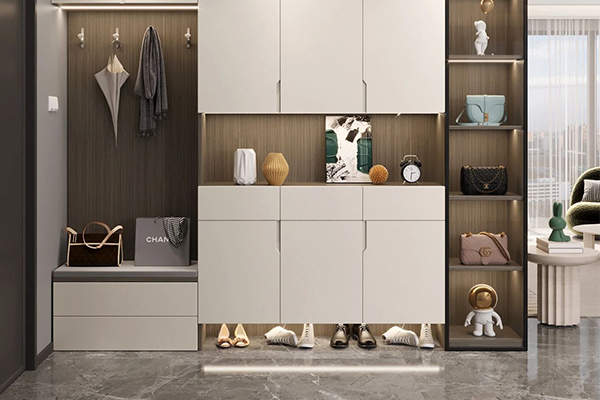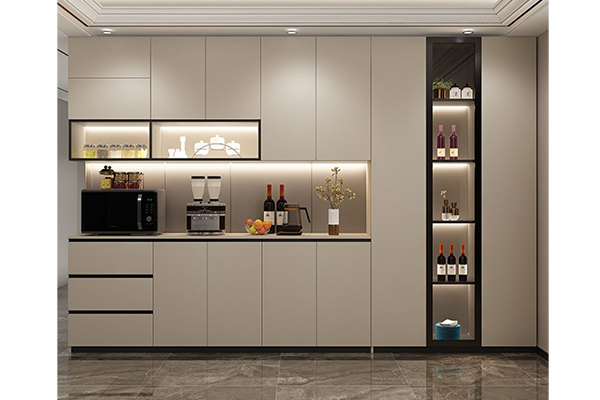Wine Cabinet is not only a storage tool for fine wine, but also a right-hand man for aging?
Release Time : 2024-11-14
Wine Cabinet is not only a storage tool for fine wine, but also a right-hand man for fine wine aging. Wine Cabinet provides an ideal aging environment for fine wine through careful design and advanced technology.
1. Temperature control
Constant temperature environment: Wine Cabinet can provide a constant temperature environment to avoid drastic temperature fluctuations. Constant temperature environment is conducive to the aging of wine, allowing it to slowly and steadily develop complex flavors and aromas.
Suitable temperature: Different types of wine require different storage temperatures. Wine Cabinet usually provides adjustable temperature settings to meet the storage needs of different types of wine such as red wine, white wine, champagne, etc.
2. Humidity control
Suitable humidity: Wine Cabinet maintains a suitable humidity level (usually between 50% and 80%) through a humidity control system to prevent the cork from drying, shrinking and mildewing. Suitable humidity helps to maintain the sealing of the cork and prevent air from entering the bottle and affecting the quality of the wine.
Prevent evaporation: A high humidity environment can reduce the evaporation of wine, maintain the amount and concentration of wine in the bottle, and facilitate the long-term storage and aging of wine.
3. Light protection
Ultraviolet protection: Wine Cabinet usually uses UV-proof glass doors or opaque materials to prevent direct light from shining on the wine. Ultraviolet rays can destroy organic compounds in wine, causing the quality of wine to deteriorate. Light protection can maintain the color and flavor of wine.
Reduce oxidation: Light can accelerate the oxidation process of wine, affecting the aging and quality of wine. The light-proof design of Wine Cabinet effectively reduces the adverse effects of light on wine.
4. Vibration isolation
Vibration isolation system: Wine Cabinet is usually equipped with a vibration isolation system to avoid the impact of mechanical vibration on wine. Vibration can interfere with the aging process of wine, affecting its flavor and quality. The vibration isolation system can provide a stable storage environment to ensure the smooth aging of wine.
Silent design: Wine Cabinet usually adopts a silent design to avoid noise interference and provide a quiet storage environment.
5. Ventilation Design
Air circulation: Wine Cabinet is usually designed with a good air circulation system to ensure uniform distribution of temperature and humidity. Air circulation can avoid uneven local temperature and humidity and keep the internal environment of Wine Cabinet stable and consistent.
Odor control: The ventilation design of Wine Cabinet can eliminate odors and prevent them from affecting wine. Odors will pollute the aging environment of wine and affect its flavor and quality.
6. Storage layout
Horizontal storage: Wine Cabinet is usually designed to place wine bottles horizontally to ensure that the cork is in contact with the wine and prevent the cork from drying and shrinking. Horizontal storage helps to maintain the sealing of the cork and prevent air from entering the wine bottle, affecting the aging of the wine.
Reasonable layout: The reasonable layout inside the Wine Cabinet can maximize the use of space and ensure that each bottle of wine can obtain the best storage environment. Reasonable layout can also facilitate the removal and placement of wine bottles to avoid the impact of frequent movement on the wine.
7. Intelligent Monitoring
Real-time monitoring: Some advanced Wine Cabinets are equipped with intelligent monitoring systems that can monitor parameters such as temperature, humidity, and vibration in real time to ensure the stability of the storage environment. The intelligent monitoring system can detect and adjust environmental parameters in a timely manner to avoid adverse factors affecting the wine.
Historical Recording: Intelligent monitoring systems usually record historical data of the storage environment, which is convenient for users to understand the storage conditions and aging process of the wine, and provide a reference for wine tasting and collection.
Wine Cabinet has become a powerful assistant for wine aging through temperature control, humidity control, light protection, vibration isolation, ventilation design, storage layout, intelligent monitoring and safety protection. Wine Cabinet can provide an ideal aging environment for fine wine, ensuring that the quality and flavor of the wine continue to improve during the aging process. Whether it is collecting high-end wines or aging high-quality spirits, Wine Cabinet is an indispensable and important tool.
1. Temperature control
Constant temperature environment: Wine Cabinet can provide a constant temperature environment to avoid drastic temperature fluctuations. Constant temperature environment is conducive to the aging of wine, allowing it to slowly and steadily develop complex flavors and aromas.
Suitable temperature: Different types of wine require different storage temperatures. Wine Cabinet usually provides adjustable temperature settings to meet the storage needs of different types of wine such as red wine, white wine, champagne, etc.
2. Humidity control
Suitable humidity: Wine Cabinet maintains a suitable humidity level (usually between 50% and 80%) through a humidity control system to prevent the cork from drying, shrinking and mildewing. Suitable humidity helps to maintain the sealing of the cork and prevent air from entering the bottle and affecting the quality of the wine.
Prevent evaporation: A high humidity environment can reduce the evaporation of wine, maintain the amount and concentration of wine in the bottle, and facilitate the long-term storage and aging of wine.
3. Light protection
Ultraviolet protection: Wine Cabinet usually uses UV-proof glass doors or opaque materials to prevent direct light from shining on the wine. Ultraviolet rays can destroy organic compounds in wine, causing the quality of wine to deteriorate. Light protection can maintain the color and flavor of wine.
Reduce oxidation: Light can accelerate the oxidation process of wine, affecting the aging and quality of wine. The light-proof design of Wine Cabinet effectively reduces the adverse effects of light on wine.
4. Vibration isolation
Vibration isolation system: Wine Cabinet is usually equipped with a vibration isolation system to avoid the impact of mechanical vibration on wine. Vibration can interfere with the aging process of wine, affecting its flavor and quality. The vibration isolation system can provide a stable storage environment to ensure the smooth aging of wine.
Silent design: Wine Cabinet usually adopts a silent design to avoid noise interference and provide a quiet storage environment.
5. Ventilation Design
Air circulation: Wine Cabinet is usually designed with a good air circulation system to ensure uniform distribution of temperature and humidity. Air circulation can avoid uneven local temperature and humidity and keep the internal environment of Wine Cabinet stable and consistent.
Odor control: The ventilation design of Wine Cabinet can eliminate odors and prevent them from affecting wine. Odors will pollute the aging environment of wine and affect its flavor and quality.
6. Storage layout
Horizontal storage: Wine Cabinet is usually designed to place wine bottles horizontally to ensure that the cork is in contact with the wine and prevent the cork from drying and shrinking. Horizontal storage helps to maintain the sealing of the cork and prevent air from entering the wine bottle, affecting the aging of the wine.
Reasonable layout: The reasonable layout inside the Wine Cabinet can maximize the use of space and ensure that each bottle of wine can obtain the best storage environment. Reasonable layout can also facilitate the removal and placement of wine bottles to avoid the impact of frequent movement on the wine.
7. Intelligent Monitoring
Real-time monitoring: Some advanced Wine Cabinets are equipped with intelligent monitoring systems that can monitor parameters such as temperature, humidity, and vibration in real time to ensure the stability of the storage environment. The intelligent monitoring system can detect and adjust environmental parameters in a timely manner to avoid adverse factors affecting the wine.
Historical Recording: Intelligent monitoring systems usually record historical data of the storage environment, which is convenient for users to understand the storage conditions and aging process of the wine, and provide a reference for wine tasting and collection.
Wine Cabinet has become a powerful assistant for wine aging through temperature control, humidity control, light protection, vibration isolation, ventilation design, storage layout, intelligent monitoring and safety protection. Wine Cabinet can provide an ideal aging environment for fine wine, ensuring that the quality and flavor of the wine continue to improve during the aging process. Whether it is collecting high-end wines or aging high-quality spirits, Wine Cabinet is an indispensable and important tool.







